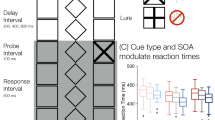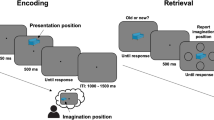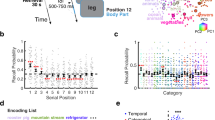Abstract
Neuroimaging studies show that the efficacy of long-term memory encoding of a stimulus is indexed by transient neural activity elicited by that stimulus. Here, we show that successful memory encoding is also indexed by neural activity that is tonically maintained throughout a study task. Using functional magnetic resonance imaging (fMRI), transient and sustained neural activity were dissociated with a mixed event-related and blocked design. In a series of short task blocks, human subjects made semantic or phonological decisions about visually presented words. After statistically removing item-related activity, we found that the mean level of activity across a task block was correlated with the number of words subsequently remembered from that block. These correlations were found in inferior medial parietal and left prefrontal cortex for the semantic task, and in superior medial parietal cortex for the phonological task. Our findings suggest that state-related activity in these brain regions is involved in memory encoding.
This is a preview of subscription content, access via your institution
Access options
Subscribe to this journal
Receive 12 print issues and online access
$209.00 per year
only $17.42 per issue
Buy this article
- Purchase on Springer Link
- Instant access to full article PDF
Prices may be subject to local taxes which are calculated during checkout




Similar content being viewed by others
References
Rugg, M.D. in Handbook of Memory Disorders 2nd edn. (eds. Baddeley, B. et al.) (Wiley & Sons, Chichester, UK, in press).
Buckner, R.L., Kelley, W.M. & Petersen, S.E. Frontal cortex contributes to human memory formation. Nat. Neurosci. 2, 311–314 (1999).
Rosen, B.R. et al. Event-related functional MRI: past, present and future. Proc. Natl. Acad. Sci. USA 95, 773–780 (1998).
Paller, K.A. & Wagner, A.D. Observing the transformation of experience into memory. Trends Cogn. Sci. 6, 93–102 (2002).
Fernández, G. & Tendolkar, I. Integrated brain activity in medial temporal and prefrontal areas predicts subsequent memory performance: human declarative memory formation at the system level. Brain Res. Bull. 55, 1–9 (2001).
Fernández, G., Brewer, J.B., Zhao, Z., Glover, G.H. & Gabrieli, J.D.E. Level of sustained entorhinal activity at study correlates with subsequent cued-recall performance: a functional magnetic resonance imaging study with high acquisition rate. Hippocampus 9, 35–44 (1999).
Chawla, D., Rees, G. & Friston, K.J. The physiological basis of attentional modulation in extrastriate visual areas. Nat. Neurosci. 2, 671–676 (1999).
Donaldson, D.I., Petersen, S.E., Ollinger, J.M. & Buckner, R.L. Dissociating state and item components of recognition memory using fMRI. Neuroimage 13, 129–142 (2001).
Otten, L.J. & Rugg, M.D. Task-dependency of the neural correlates of episodic encoding as measured by fMRI. Cereb. Cortex 11, 1150–1160 (2001).
Snodgrass, J.G. & Corwin, J. Pragmatics of measuring recognition memory: applications to dementia and amnesia. J. Exp. Psychol. 117, 34–50 (1988).
Wagner, A.D. et al. Building memories: remembering and forgetting of verbal experiences as predicted by brain activity. Science 281, 1188–1191 (1998).
Brewer, J.B., Zhao, Z., Desmond, J.E., Glover, G.H. & Gabrieli, J.D.E. Making memories: brain activity that predicts how well visual experience will be remembered. Science 281, 1185–1187 (1998).
Otten, L.J., Henson, R.N.A. & Rugg, M.D. Depth of processing effects on neural correlates of memory encoding: relationship between findings from across- and within-task comparisons. Brain 124, 399–412 (2001).
Davachi, L., Maril, A. & Wagner, A.D. When keeping in mind supports later bringing to mind: neural markers of phonological rehearsal predict subsequent remembering. J. Cogn. Neurosci. 13, 1059–1070 (2001).
Poldrack, R.A. et al. Functional specialization for semantic and phonological processing in the left inferior prefrontal cortex. Neuroimage 10, 15–35 (1999).
Shallice, T. et al. Brain regions associated with acquisition and retrieval of verbal episodic memory. Nature 368, 633–635 (1994).
Bernstein, L.J., Beig, S., Siegenthaler, A.L. & Grady, C.L. The effect of encoding strategy on the neural correlates of memory for faces. Neuropsychologia 40, 86–98 (2002).
Buckner, R.L., Wheeler, M.E. & Sheridan, M.A. Encoding processes during retrieval tasks. J. Cogn. Neurosci. 13, 406–415 (2001).
Henson, R.N.A., Rugg, M.D., Shallice, T., Josephs, O. & Dolan, R.J. Recollection and familiarity in recognition memory: an event-related functional magnetic resonance imaging study. J. Neurosci. 19, 3962–3972 (1999).
Gusnard, D.A. & Raichle, M.E. Searching for a baseline: functional imaging and the resting human brain. Nat. Rev. Neurosci. 2, 685–694 (2001).
Josephs, O. & Henson, R.N.A. Event-related functional magnetic resonance imaging: modelling, inference and optimisation. Phil. Trans. R. Soc. Lond. B Biol. Sci. 354, 1215–1228 (1999).
Rugg, M.D., Otten, L.J. & Henson, R.N.A. The neural basis of episodic memory: evidence from functional neuroimaging. Phil. Trans. R. Soc. Lond. B Biol. Sci. 357, 1097–1110 (2002).
Pashler, H., Johnston, J.C. & Ruthruff, E. Attention and performance. Annu. Rev. Psychol. 52, 629–651 (2001).
Kucera, H. & Francis, W.N. Computational Analysis of Present-day American English (Brown Univ. Press, Providence, Rhode Island, 1967).
Friston, K.J. et al. Statistical parametric maps in functional imaging: a general linear approach. Hum. Brain Mapp. 2, 189–210 (1995).
Ashburner, J. & Friston, K.J. Nonlinear spatial normalization using basis functions. Hum. Brain Mapp. 7, 254–266 (1999).
Friston, K.J. et al. Event-related fMRI: characterising differential responses. Neuroimage 7, 30–40 (1998).
Friston, K.J. Imaging cognitive anatomy. Trends Cogn. Sci. 1, 21–27 (1997).
Holmes, A.P. & Friston, K.J. Generalisability, random effects and population inference. Neuroimage 7, 754 (1998).
Otten, L.J. & Rugg, M.D. When more means less: neural activity related to unsuccessful memory encoding. Curr. Biol. 11, 1528–1530 (2001).
Cocosco, C.A., Kollokian, V., Kwan, R.K.S. & Evans, A.C. BrainWeb: online interface to a 3D MRI simulated brain database. Neuroimage 5, S425 (1997).
Henson, R.N.A., Rugg, M.D. & Friston, K.J. The choice of basis functions in event-related fMRI. Neuroimage 13, 149 (2001).
Acknowledgements
This work was supported by the Wellcome Trust and a cooperative award from the United Kingdom Medical Research Council. MRI scanning took place at the Wellcome Department of Imaging Neuroscience, Institute of Neurology, London, UK.
Author information
Authors and Affiliations
Corresponding author
Ethics declarations
Competing interests
The authors declare no competing financial interests.
Rights and permissions
About this article
Cite this article
Otten, L., Henson, R. & Rugg, M. State-related and item-related neural correlates of successful memory encoding. Nat Neurosci 5, 1339–1344 (2002). https://doi.org/10.1038/nn967
Received:
Accepted:
Published:
Issue Date:
DOI: https://doi.org/10.1038/nn967
This article is cited by
-
Non-invasive temporal interference electrical stimulation of the human hippocampus
Nature Neuroscience (2023)
-
Theta Coherence Asymmetry in the Dorsal Stream of Musicians Facilitates Word Learning
Scientific Reports (2018)
-
The Influence of Pre-stimulus EEG Activity on Reaction Time During a Verbal Sternberg Task is Related to Musical Expertise
Brain Topography (2016)
-
Brain activity before an event predicts later recollection
Nature Neuroscience (2006)
-
Visuospatial Memory Deficits Emerging During Nicotine Withdrawal in Adolescents with Prenatal Exposure to Active Maternal Smoking
Neuropsychopharmacology (2006)



